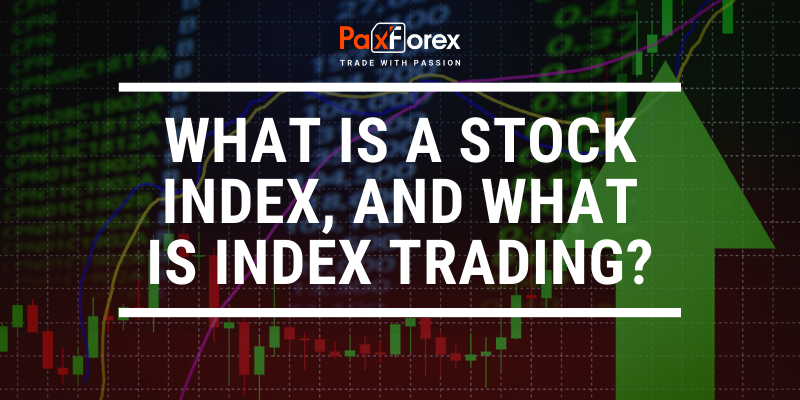
Many traders, starting their way in the Forex trading, think that they can only trade currency pairs, maybe even gold sometimes. But in fact, there are a lot of trading assets that meet the eye. In trading terminals, some new appearing assets may still be underestimated by new market participants.
At the moment, a trader can choose any instrument based on his preferences and tastes. These can be currency pairs, cryptocurrencies, CFD, stocks, futures, and stock indices. It is no secret for confident traders that trading stock indices brings much more profit and carries much less risk than trading in ordinary shares or Forex. So, today we will find out what a stock index will discover, how it's calculated, as well as how to get the most out of indices trading applying different types of strategies. Let`s get started.
What is Index Trading?
Stock indices catalyze the economy of the whole region, specific industries, and, in general, shows how well a particular market sector is developed and what its potential is. Working with stock indices as a trading instrument is important because it provides advantages that other types of assets do not have. In particular, a trader has the opportunity to work more precisely.
After all, there is a huge number of indexes. In most cases, they are composed in such a way that they can characterize the country's economy, the development of industries, grouped by similar companies, and so on. The trader can select the indices in which he understands the most accurately.
For example, if you have a good understanding of the U.S. industry, it will be difficult for you to trade the dollar because it is not the only sector of the economy that has influence. But using the U.S. Industrial Average Index is very effective
So, let us see what index is and it works.
What is a Stock Index?
There are many reasons why people need to know how the stock market behaves in this or that country. For some it is an indicator of economic development, for others it is a potential investment attraction, etc. Therefore, there is a need to show people what is going on in the stock market of a country or region (this applies to any country or region of the world) simply and conveniently.
Since tracking every stock in a country is not a simple and convenient form, special market indicators have been invented to summarize what is happening on the entire stock market and to produce them in a simple and acceptable form. These indicators are called stock indices.
The stock index is a numerical index of change in the value of a group of securities. In other words, it is a basket or a grouping of shares combined on a selective basis.
There is a great variety of stock indices at the world stock exchange. They can be traded along with other financial instruments. But what are these indexes for?
Mainly, the indices are necessary for investors to simplify the stock market analysis. Since the index is composed of shares, its change can say a lot about the position of the whole segment of the economy. Thus, an investor does not need to analyze the shares of each enterprise in the industry to understand its economic situation.
How Do Stock Market Indices Work?
The logic behind the stock indices is very simple - if you see that S&P 500 quotes are moving down, it means that the total value of the shares included in this index is going down. The opposite situation shows the growth of companies in the technology sector.
The fall of the index does not mean that all of the stocks that make up the index are moving downwards synchronously. To assess the stock market situation, it is important to know the average value. Because some stocks may become cheaper, while others may become more expensive at the same time.
So, let us move to the next part to find out how stock indices are calculated.
How Are Stock Indices Calculated?
There are four main ways to calculate the stock index:
calculation of the unweighted arithmetic mean. It is how the Dow Jones Industrial Average is determined.
calculation of the weighted arithmetic mean. Here different methods of weighting are used: by the price of shares in the sample, by the value of the companies, equating the weight of shares of companies. In this way, the index of Standard & Poor's rating agency is determined (abbreviated as S&P 500).
calculation of the unweighted geometric mean. This formula uses the oldest index of Great Britain FT-30 (FT-30 Share Index, Financial Times Industrial Ordinary Index).
calculation of the weighted geometric mean. It is used to determine the Value Line Composite Average Index (US stock market).
Don`t worry, you do not need to know all the details of the formulas to trade. He needs to understand that the stock index is an average of a specified group of shares, reflecting the state of a particular market sector (for example, "blue chips" or industrial companies). In other words, we do not need to take all shares of a given sector and calculate the average - only shares of the most representative companies are used. It shows the representativeness (visibility) of the use of the stock indices.
The real calculation of indices is done by various organizations, most often information or rating agencies, as well as the stock exchange itself.
Why Trade Stock Market Indices?
Trading stock indices has a lot of advantages, including:
You can buy or sell several hundred shares of large companies at once with minimum investment;
High liquidity and volatility;
Convenient tracking of market dynamics and trends by segments and economy as a whole;
The best option for long-term investments;
The index quotes are influenced first of all by the rates of securities, which are a part of it;
High diversification.
An essential characteristic of indices is that they are highly predictable. It is much easier to work with indices than with currencies, commodities, or stocks. It is because, in most cases, there is a definition of several large companies, and it is much easier to predict a particular industry than to understand all the nuances of an underlined firm. For example, the S&P 500 is calculated based on the shares of the 500 largest firms. You can trade it 24/5.
Trading Stock Indices Vs. Investing in Stocks
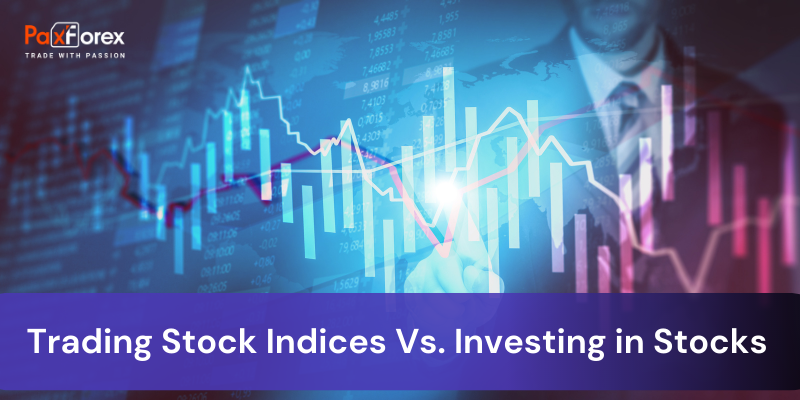
Stock index quotes can be used for various purposes. Let us consider the most relevant ones:
analysis of the current situation on stock markets;
trading CFDs on indices;
risk hedging.
At first glance, it seems that index trading is similar to stock trading. And there is a certain amount of truth in it - indices reflect the total value of a certain list of securities. However, there are many beneficial features. When you trade indices, you don't put yourself at risk of falling shares of particular companies. This financial instrument is affected by the total value of the assets that are included in it.
CFDs on indices can be traded with leverage, so you do not need to have significant capital to invest. Traders can open both long and short positions. It is possible to trade indices using both short-term and long-term strategies.
The financial instrument under consideration is popular among both institutional and individual traders. Indices also have some trading advantages over other derivatives: options and futures.
And there are good reasons for that. When working with options and futures, one has to deal with expiry dates. When you trade indices, you will not have such problems. You can hold a CFD position for an unlimited time. Thus, you can wait for the drawdown of the index quotes until they return to more favorable values.
Index Trading Vs. Forex Trading
Trading indices has definitely more advantages compared to currencies. Let's have a look at some of them:
Emerging Markets
Stock or equity markets are usually emerging markets. Unlike Forex, the more flat market, where trends are much less common and most of the time trading is in a sideways trend.
Stock indices tend to grow slowly and for a long time - but they do fall quickly and sharply (another peculiarity, as described below).
Trend markets
The second feature follows from the first - stock indices are a more trendy asset than currencies. At that, on any time frame that is within a day - or within a week, month or year. If the indices are growing, they can grow the whole session almost without pullbacks - and fall as well. That's why it's very difficult for Forex traders who are used to sideways movement to trade indices.
Seasonality in trading
Stock indices have a pronounced seasonality in trading. In some months they mostly grow, for example in December (the so-called Christmas rally) - while in others they usually fall, for example, in May or October.
Brightly distinct features of movement within a day
Stock indices also have peculiarities of movement inside the day related to the beginning, middle, and end of the trading session. For example, strong movements in the first hour of the American session.
The strongly developed technicality of indexes
Stock indices are very technical - and all figures of technical analysis, Japanese candlesticks, levels, etc. are working on them. That has been working not that good in Forex for a long time or even stopped working at all.
Special reaction to the macro indicators
Stock indices do not react well to most of the usual indicators from the Economic Calendar, except for some very important ones, such as U.S. labor market data. Therefore, those accustomed to Forex trading here will have to adjust their views a little.
But this reaction to the indicators, if any, is much more accurate and adequate than the currency. The U.S. labor market is strong, and the indices are growing until the end of the session.
Which Stock Indices Are Popular for Index Trading?
The most famous all over the world are American stock indices. It was in the U.S., where the first stock index, the Dow Jones Index, appeared, which still exists today.
In addition to the transport index Dow Jones Transportation Average there are also industrial (Dow Jones Industrial Average) and utility (Dow Jones Utilities Average) indices.
Let us have a look at the most popular stocks: US indices, EU indices, as well as Asian ones.
Popular US Stock Indices
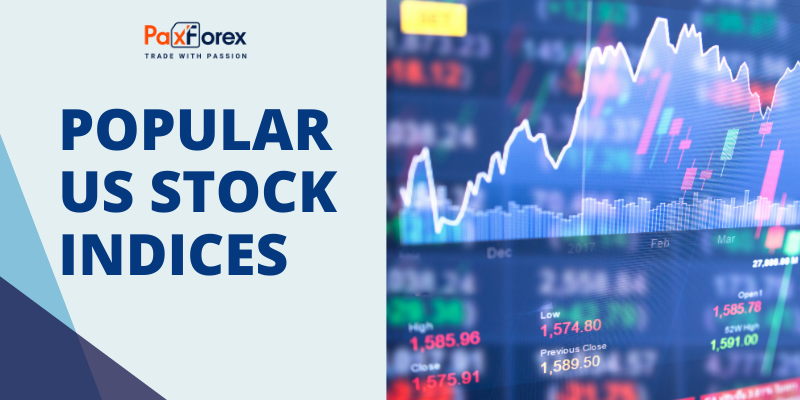
Since the U.S. stock market is one of the largest in the world, the U.S. stock indices are huge. We will look at the most popular and influential stock indices.
DJ30 - Dow Jones Industrial Average
The Dow Jones Index is used to assess the state of the US industry, although it is one of the world's largest stock indices. The full name of the index is Dow Jones Industrial Average. During the period of existence of the Dow Jones Industrial Average Index, rotation of firms has been conducted repeatedly. Since 1916, the list of companies influencing this value was increased to 20, and from 1928 - to 30. The list included companies from different fields: telecommunications, energy, finance, wholesale and retail, pharmaceuticals, and consumer services.
The officially published Dow Jones index value was 40.94. The index was calculated as a mean of the value of shares of the companies that make up the "basket" of the index. As the USA economy developed and the composition of companies changed, its value changed dramatically. Thus, the maximum limit of 1,000 points was reached in 1966, which was maintained for 15 years, during which the index value was significantly decreasing (up to one-third of the maximum) and returned to the starting point.
In the 1980s and 90s, there was an explosive growth in the Dow Jones Index value up to 11,722.98 (January 2000). Within this period, there were drops to 22%, but this had no significant impact on the overall market value dynamics of this index. The most notable collapse was recorded on Black Monday, 1987. At the end of 2017, the traded value was within 23,000 units.
One of the key applications of the Dow Jones Index is its use as a trading instrument on the stock exchange. It is easy to analyze, which leads to the inclusion of the index in investment portfolios of a large number of traders.
Among the advantages of trading this index, the following is noted:
The index exists for a long time, which allows an objective comparison of the state of the American economy at any stage.
The companies included in the index are recognized as reliable and stable, including their shares and other assets (which are actively used by traders).
The simplicity of calculation without application of special formulas (arithmetic average is applied).
However, we can not but mention some disadvantages:
All companies have the same "weight" in calculating the average. When the securities of one company fall, the general value can be freely compensated by the growth of quotes of other companies, which can mislead the trader.
Only 30 companies do not always objectively reflect the real state of the US market. The value is good for the analysis of certain periods, but in the current market has "small objectivity."
The latter factor leads to the loss of popularity of this trading instrument, and in favor of a similar indicator - the S&P 500 index, which includes the value of 500 U.S. companies. This expansion of the "basket" was necessary for an overall assessment of the USA domestic market and its interaction with other countries.
SP500 - Standard and Poor's Index
The Standard & Poors 500 Index (S&P 500) is one of the most popular stock market indices in the U.S., competing for the championship with the Dow Jones Index. Even though the Dow Jones Index is considered an old classical market indicator, it includes only 30 companies. The S&P 500 is far ahead of the Dow Jones in this respect: the S&P 500 includes 500 companies which, for objective reasons, represent the situation in the entire market much more accurately.
The S&P 500 index was launched in 1957 by the McGraw-Hill member company of the same name. Before the S&P 500, there were other indexes of this company, such as the S&P 90, but the S&P 500 as it is today was launched only in 1957.
The S&P 500 Index includes 500 companies, as mentioned earlier. But there is an important nuance here: unlike the Dow Jones Index, which includes only blue chips (large, "elite" companies) not from all industries, the S&P 500 Index includes companies that are included in all industries and are not blue chips but are the most in-demand companies that most objectively represent the industry and market as a whole.
The companies are selected by the index committee. Due to various phenomena (such as mergers and liquidation), the S&P 500 index composition changes up to 50 times a year. Often, the work of portfolio managers is assessed by comparing the profitability of their portfolios with the S&P 500 index.The main advantage is its role in the global economy: the S&P 500 index perfectly reflects the U.S. market and is well diversified. The task of many investment managers is to exceed the profitability of the S&P 500 index. But the disadvantage of the index is the fact that the 45 largest entering companies account for more than half of the index value.
NQ100 - Nasdaq stock index
The Nasdaq 100 index is the total value of shares of the 100 largest, most actively traded U.S. companies listed on the NASDAQ stock exchange. The index includes companies from different industries: retail, biotechnology, industry, technology, healthcare. The index is based on a method that allows limiting the influence of large companies and balancing the index against all companies.
As for the pros and cons of this very index, is necessary to start with the disadvantages, as there are few of them. To be more precise, one: the market is specialized, designed for fast-growing companies, so even a slowdown in growth, not to mention stagnation or decline, causes a nervous reaction of investors, as it was at the end of 2018.
But when stability returns, it is the NASDAQ companies that attract major investments, the ratio returns to growth. Therefore, the profit when investing in the index exceeds similar investments in Dow Jones or S&P.
How to Trade US Stock Indices
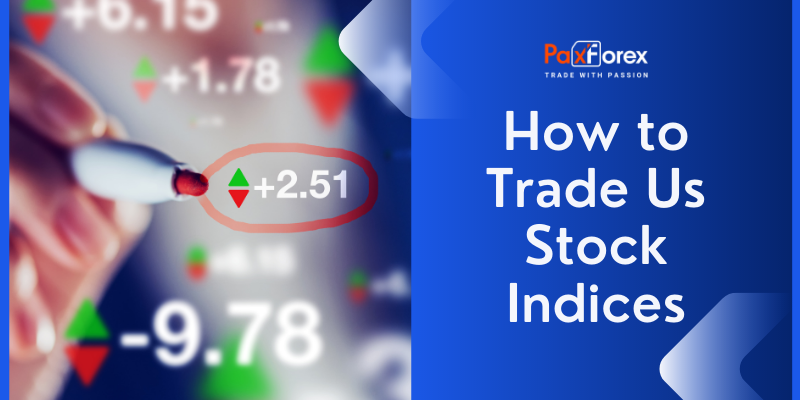
The best way to trade indices is with the help of CFDs. The contract for Difference is one of the fastest-growing financial products on the market today. CFDs allow investors to trade all the world's stock indices from the platform while gaining access to incredible levels of leverage.
With CFDs on stock indices, you can profit from index fluctuations in the same way as you can profit from fluctuations in the value of individual stocks or exchange rates.
By opening a CFD position, the trader essentially agrees to a change in the price of the index at the end of the period. In other words, a CFD is an agreement between a trader and a broker to
exchange the difference between the current index price and the future value of the index. If you have a long position open and the difference is positive, the broker will pay you. If the difference is negative, you pay.
The price of the CFD index is directly related to the corresponding future price of that index. The price movement of an index CFD tracks the corresponding future price movement of that index.
Trading CFDs on indices provides an excellent way to speculate on each stock market as a whole, rather than selecting stocks and companies. In fact, index CFDs are often considered less risky than individual stocks because the risk extends to the market as a whole, rather than to a single company.
Popular European stock indices: European stock indices are not as popular as American ones, but still can be a great option for investment. Among the most famous ones are FTSE100, DAX30, STOXX 50, and CAC40.
- The UK stock index - FTSE 100
It`s a stock index calculated by the Financial Times agency. It is considered one of the most influential stock exchange indicators in Europe. It started to be calculated on January 3, 1984, from 1000 points.
FTSE 100 index includes quotes of 100 companies with the largest market capitalization (over 80% of the total) on the London Stock Exchange. To be included in the calculation, several strict FTSE Group criteria must be met:
listing on the London Stock Exchange;
asset value is estimated in pounds or euros;
belongs to the established country;
shares are liquid and freely tradable.
These blue chips are evaluated once a quarter to confirm their status.
Since entering the top hundred of the world's companies according to the London Stock Exchange for the British corporation requires only the mandatory 25% free-float, and for foreign companies - 50% free-float, it is necessary to be a little cunning. Participants register their head offices in the UK, despite the lack of actual economic connection with it - this is what Swiss, American, South African, Chilean, Australian, and some other large companies did. The benefit for the United Kingdom is obvious since taxes are collected in the local treasury.
Therefore, it is not surprising that 53% of the capitalization of this group falls on British companies. Firms from the U.S. have 15% of the total value, while European countries have 14%, etc.
The FTSE stock index takes into account enterprises of all sectors of modern business, including 11 mining companies, 29 consumer goods, and services, 24 financial and investment sectors, 20 engineering, 5 health care, 5 oil and gas, 6 telecommunication technologies, etc.
The German stock index - DAX 30
Indicator of 30 leading German companies, including capitalization and order volumes. Calculated at the share prices of the electronic exchange Xetra. The selection for listing is pretty tough: registration in the European Union, main office - in Germany, at least 5% of shares in free circulation, and a large turnover at the Frankfurt Stock Exchange. It has an L-DAX clone, the development of which is monitored by Deutsche Boerse AG after the closing of the exchange, and a number of industry options.
- The French stock index - CAC 40
CAC 40 Index is a French stock index calculated on the basis of prices of forty largest companies represented on the Paris Stock Exchange.
- The Eurozone stock index - STOXX 50
Euro Stoxx 50 Index - was created on the basis of shares of the fifty largest companies located in the European Union.
Popular Asia-Pacific Stock Indices
Asia-Pacific stock indices, together with the Japanese index, are of interest because they actually set the trading tone at the beginning of the day, thus indicating the prospects for further stock market movement after the U.S. session in the middle of the week and the mood at the beginning of the week. Often, in the Asia-Pacific trading session, there is a correction against trading in the U.S. session. And often, you can find the expression "Asian session corrects the mistakes of the American session." It is due to the correction model of the market movement. Thus, after the growth or decline in trading in America, trading in the Asia-Pacific region goes the other way, thus correcting the market. Let's have a look at some of those indices.
- The Japanese stock index - Nikkei 225
The indicator, now known as Nikkei 225, began to be calculated in May 1949. The composition of the Nikkei 225 is reviewed once a year, in September. The basis of the index, as well as in the case of Dow Jones, are companies of the real economy sector: industry, construction, transport, real estate, energy, and finance.
The names of some of the companies included in the index have been on everyone's lips for many years. For example, the list of companies included in the Nikkei sector "Automotive Industry": Honda, Mazda, Mitsubishi, Nissan, Suzuki, Toyota.
- Chinese stock indices - the SSE Composite Index, and the CSI 300
When it comes to the Chinese indices, two names spring to mind -
SSE Composite Index and CSI 300.
First off, the SSE Composite Index is the main stock index of China, which has been calculated since its opening in December 1990. Daily price values of all shares traded in quotation lists A
and B of the Shanghai Stock Exchange are taken into account.As for the CSI 300, it is the Shanghai Stock Exchange and Shenzhen Stock Exchange Index. It includes the shares of 300 largest Chinese companies, the largest weight of Ping An Insurance Group, Kweichow Moutai, China Merchants Bank.
- The Hong Kong stock index - HSI50
HSI stands for Hang Seng Index. It is one of the most popular indices in the world. The capitalization of companies from Hang Seng is 57.4% of the total capitalization of the stock exchange. Therefore, it is possible to judge HSI about the general situation in the Asian market
- The Australian stock index - the ASX 200
Australian ASX 200 includes shares of the 200 largest companies, which account for about 85% of the entire capitalization of the exchange. It is neither a blue-chip nor a composite index. Still, ASX 200 fully shows the state of the Australian market and its economy, which is developing at approximately the same pace.
The ASX 200 is a capitalization-weighted index that varies according to the share price, adjusted for the company's capitalization. If a company increases its capitalization by increasing its share capitalization, the formula does not allow it to influence the index.
Index Trading Strategies and Time Frames
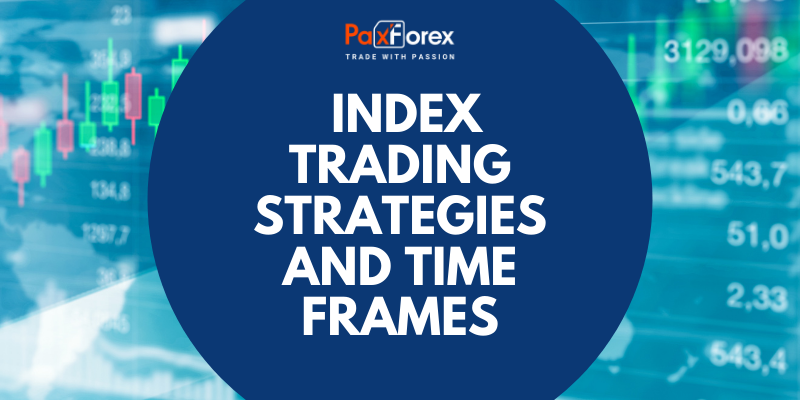
Since trading indices is just like trading any other asset, the choice of time frame should fully depend on the applied strategy. For intraday trading, price gaps have no critical impact, but in this case, it is better to choose timeframes from 5 minutes to 30. It will allow the analysis of more candlesticks with almost no gaps.
- Scalping indices
Scalping is characterized by short position time (no longer than 3-5 minutes) and a small profit, a maximum of 5-10 points. Forced closing of the automatic trading area after the set time has expired, and profit-taking can also be done manually. A time frame should be mentioned separately - it can be not only a minute but good results can be obtained on M5-M15 as well.
- Day trading indices
Day trading means trading indices during the day. In this case, all trades are closed within a day, and occasionally can be carried over to the next day. It brings higher risks and profitability compared to long-term trading, as well as a large number of trades are closed during the day. A day trader pays maximum attention to technical analysis and much less to the fundamental one.
- Swing trading stock indices
It's a method of trading that is based on fluctuations at the time of trend formation. In general, it is a set of Forex strategies, the main purpose of which is to enter a trend at the moment of reversal (when it is formed) and make a profit. The risk, in this case, should be minimal. For these reasons, the main features of swing trading are the use of day/week time frames and clear risk management.
The Best Platform for Index Trading
Going through the fundamentals of trading stock indices and learning how to make the most out of them with different strategies, you may be feeling ready to get started. The first and, probably, most vital question now is what trading platform is the best for indices trading.
Speaking about the platforms, most traders will tell you about the MetaTrader 4. And it is not surprising due to its reliability and reputation. Everything necessary for trading, many traders find exactly in this terminal.
MetaTrader 4 is a convenient and clear platform for trading stock indices, performing trading operations, technical analysis using indicators, testing trading systems, and working with EAs. And for smartphones on Android and IOS, there are mobile applications, which provide continuous access to trade.
And, trading with PaxForex, you will be able to trade not only indices but currencies, stocks, precious metals, and cryptocurrencies. Boost your profitability with broadened trading opportunities! Join the family today!







